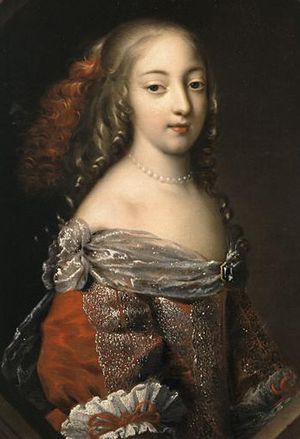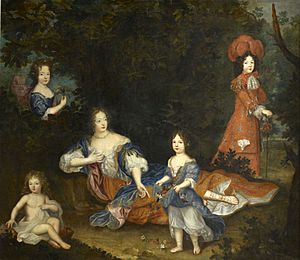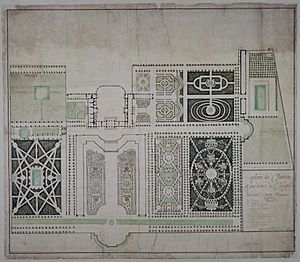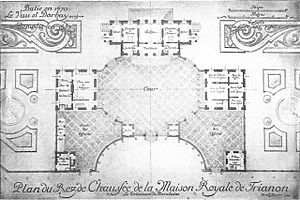Françoise-Athénaïs de Rochechouart, Marquise de Montespan facts for kids
Quick facts for kids Madame de Montespan |
|
|---|---|
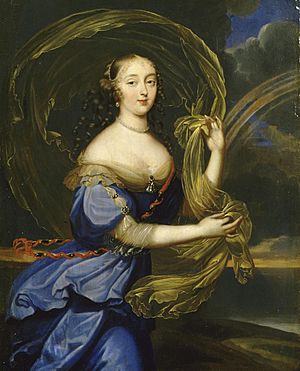 |
|
| Contemporary portrait of Françoise by an unknown artist | |
| Spouse(s) | |
| Issue | |
|
|
| Full name | |
| Françoise Athénaïs de Rochechouart de Mortemart | |
| Noble family | Rochechouart (by birth) Pardaillan de Gondrin (by marriage) |
| Father | Gabriel de Rochechouart de Mortemart |
| Mother | Diane de Grandseigne |
| Born | 5 October 1640 Lussac-les-Châteaux, France |
| Baptised | 5 October 1640 Lussac-les-Châteaux, France |
| Died | 27 May 1707 (aged 66) Bourbon-l'Archambault, France |
| Occupation | Important figure at the French court |
Françoise-Athénaïs de Rochechouart de Mortemart, Marquise of Montespan (October 5, 1640 – May 27, 1707), also known as Madame de Montespan, was a very important person at the court of King Louis XIV of France. She had seven children with the King.
She was born into the House of Rochechouart, one of France's oldest noble families. Some people called her the "true Queen of France" because of her great influence at court. This period of influence lasted from about 1667. It began when she first danced with King Louis XIV at a ball. This ball was hosted by the King's younger brother, Philippe I, Duke of Orléans, at the Louvre Palace.
Madame de Montespan is an ancestor of several royal families in Europe today. These include the royal families of Spain, Italy, Bulgaria, Portugal, Belgium, and Luxembourg.
Contents
Early Life and Family
Françoise-Athénaïs was born in October 1640. She was baptized on October 5, 1640, at the Château of Lussac-les-Châteaux in France. Françoise later chose the name "Athénaïs." Her formal title was Mademoiselle de Tonnay-Charente. She came from two of France's oldest noble families through her parents. Her father was Gabriel de Rochechouart de Mortemart, Duke of Mortemart. Her mother was Diane de Grandseigne, a lady-in-waiting to Queen Anne of Austria.
From her father, she inherited a famous family trait: a sharp "wit." As a young girl, she often traveled with her mother. They went between their family estates and the royal court in Paris. At age 12, she started her formal education. She attended the Convent of St Mary at Saintes. Her sister Gabrielle had started school there almost ten years earlier. Françoise was very religious and took Communion weekly. She continued this practice as a young woman.
Her siblings were:
- Gabrielle (1633–1693): She married Claude Léonor Damas de Thianges. They had children.
- Louis Victor (1636–1688): Known as the Marquis of Vivonne. He was a childhood friend of Louis XIV of France.
- Marie Madeleine Gabrielle Adélaïde (1645–1704): She was known as the Queen of Abbesses.
At age 20, Françoise-Athénaïs became a maid-of-honour. She served the king's sister-in-law, Princess Henrietta Anne of England. Henrietta was known at court as Madame. Later, Françoise-Athénaïs became a lady-in-waiting to the king's wife, Maria Theresa of Spain. This happened because of her mother's connection to the Queen Mother, Anne of Austria.
Marriage and Early Court Life
On January 28, 1663, Françoise-Athénaïs married Louis Henri de Pardaillan de Gondrin, Marquis of Montespan. He was one year younger than her. The wedding took place in a chapel at the Église Saint-Eustache in Paris. Françoise later joked that they had to kneel on dog cushions during the ceremony. This was because they forgot to bring proper kneeling cushions.
She quickly became pregnant with her first child, Christine. Two weeks after Christine's birth, Françoise danced in a Court Ballet. Less than a year later, her second child was born.
The Montespan children were:
- Marie Christine de Pardaillan de Gondrin (1663–1675): She passed away at the Château de Bonnefont.
- Louis Antoine de Pardaillan de Gondrin, Marquis of Antin (1664–1736): He later became the Duke of Antin. Louis Antoine had a good relationship with his younger half-brothers. These were the Duke of Maine and the Count of Toulouse.
The couple lived in a small house near the Louvre. This allowed Madame de Montespan to attend court and perform her duties. She quickly became known as the "reigning beauty of the court." But her beauty was just one of her many charms. She was also a cultured and entertaining speaker. She earned the admiration of famous writers like Madame de Sévigné. She also stayed informed about political events. This made her even more appealing to powerful and intelligent men.
Becoming Important to Louis XIV

By 1666, Madame de Montespan wanted to become the most important woman to King Louis XIV. At that time, Louise de La Vallière held that position. Madame de Montespan used her wit and charm to get closer to the King. She also became good friends with the Dauphin, the King's son. His affection for her never changed.
Louise de La Vallière knew Montespan was trying to win the King's heart. She reportedly laughed at Montespan's attempts. But Louise clearly underestimated her new rival. Montespan cleverly made friends with both Louise and Queen Maria Theresa. When both ladies were pregnant, Madame de Montespan was asked to help entertain the King during private dinners. Soon, they regretted this decision. Montespan began to develop a very close relationship with the King.
She also became friends with another lady-in-waiting to the Queen, Louise Boyer. Louise Boyer was the wife of Anne, Duke of Noailles. Montespan's youngest son, the Count of Toulouse, would later marry one of Boyer's granddaughters.
Children with King Louis XIV
The first of Madame de Montespan's seven children with the King was born in 1669. This newborn girl was likely named Louise-Françoise. The care of this first child, and later children, was given to Madame Scarron. She would later become the marquise de Maintenon. A son, Louis-Auguste, was born in 1670. When their third child, Louis-César, was born in 1672, a house was bought for Scarron and the children.
In 1673, the couple's three living children were officially recognized by Louis XIV. They were given the royal last name de Bourbon. The oldest son, Louis-Auguste de Bourbon, became the duc du Maine. The second son, Louis-César de Bourbon, became the comte de Vexin. The third child, a daughter, Louise-Françoise de Bourbon, became Mademoiselle de Nantes. In 1685, she married the son of the head of the House of Condé. This was a branch of the ruling House of Bourbon. Madame de Montespan spent most of her time at court. Because of this, the three children had little contact with their busy mother. They spent most of their childhood with their governess, Madame Scarron.
In 1674, an official separation from her husband was declared. This was done by the Procureur général Achille de Harlay.
After a short time apart, the King and Madame de Montespan continued their relationship. This led to the birth of two more children. These were Françoise Marie de Bourbon, Mademoiselle de Blois, in 1677. And Louis-Alexandre de Bourbon, comte de Toulouse, in 1678. Both of these children were officially recognized in 1681.

Appearance and Character
Athénaïs was considered "amazingly beautiful" for her time. She had large, blue eyes. Her hair was long, thick, and corn-colored. It fell in curls around her shoulders. She was witty and entertaining. She often used her cleverness to tease others.
She also had a very grand and demanding personality. But she had enough charm to get what she wanted. She loved expensive and grand things, much like the Palace of Versailles itself. Her rooms were filled with pets and thousands of flowers. She had a private art gallery. Costly jewels were given to her. She was very particular about the quality of her gems. She would send them back if they did not meet her high standards. She was given the nickname Quanto, which means "How much" in Italian. As she got older, her love for food and her many pregnancies caused her to gain weight.
Royal Residences and Legacy
Château de Clagny
The Château de Clagny in Versailles was built between 1674 and 1680. It was designed by Jules Hardouin-Mansart, the King's main architect. The land for it was bought by Louis XIV in 1665. Madame de Sévigné wrote that building it required 1,200 workers. The cost was at least 2 million "livres." The royal gardener André Le Nôtre created the gardens. They faced west towards the much larger Palace of Versailles. Clagny was like a smaller version of Versailles. The château de Clagny was also famous for its art gallery. In 1685, Louis XIV gave this magnificent palace to Madame de Montespan.
After her death, Clagny was inherited by her oldest son, the duc du Maine. He then passed it on to his son, Louis-Auguste de Bourbon, prince de Dombes. The château returned to the French crown in 1766. It was torn down in 1769.
Trianon de Porcelaine
Louis XIV also had a special building called the Trianon de Porcelaine built for Madame de Montespan. It was surrounded by gardens. It was located where the old village of Trianon used to be, near the Palace of Versailles. This building was meant to be a private retreat for the King and Madame de Montespan. Because the earthenware tiles used to build it were fragile, the Trianon de porcelaine was taken down in 1687. It was replaced by the Grand Trianon, which was made of pink marble.
Children by Louis XIV
| Name | Birth | Death | Notes |
|---|---|---|---|
| Louise Françoise de Bourbon | at the end of March, 1669 | February 23, 1672 (aged 2) | |
| Louis Auguste, Duke of Maine | March 31, 1670 | May 14, 1736 (aged 66) | Officially recognized on December 20, 1673. Held many important roles. He was the founder of the Maine Line. |
| Louis César, Count of Vexin | June 20, 1672 | January 10, 1683 (aged 10) | Officially recognized on December 20, 1673. |
| Louise Françoise de Bourbon | June 1, 1673 | June 16, 1743 (aged 70) | Officially recognized on December 20, 1673. Married Louis III, Prince of Condé. They had children. |
| Louise Marie Anne de Bourbon | November 12, 1674 | September 15, 1681 (aged 6) | Officially recognized in January 1676. |
| Françoise Marie de Bourbon | February 9, 1677 | February 1, 1749 (aged 72) | Officially recognized in November 1681. Married Philippe II, Duke of Orléans. He was the Regent of France during Louis XV's childhood. They had children. |
| Louis Alexandre, Count of Toulouse | June 6, 1678 | December 1, 1737 (aged 59) | Officially recognized on November 22, 1681. Held many important roles, including Admiral of France. He had children. |
Images for kids
-
Madame de Montespan's two surviving daughters: the blonde Mademoiselle de Blois, with her older brunette sister, the Mademoiselle de Nantes
-
Louise Françoise some time after her marriage to Louis III, Prince of Condé
See also
 In Spanish: Madame de Montespan para niños
In Spanish: Madame de Montespan para niños


